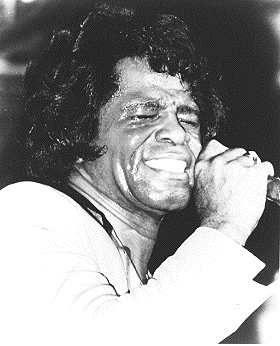
The Message and the Music
One of the specific outcomes of the Common Curriculum is to offer evidence that works of art can communicate ideas and reflect social, political and cultural conditions (A9). The music defined loosely as 'Rock & Roll' both influenced and was influenced by the the Civil Rights Movement in America. This page will show rock & roll both communicated the ideas of the Civil Rights Movement and reflected the social and political conditions of blacks in America.
In the Beginning: the 50's
'Rock & Roll' has always been considered dangerous. While black musicians had always found conditions difficult, the early rock & roll artists often found themselves on the front lines in the battle for desegregation and equal rights. In many American towns, the first racially integrated public functions were rock & roll concerts. Originally, rock & roll concerts were organized so that black spectators sat down in front of the stage while white spectators sat up in the balconies. After watching the blacks having so much fun dancing down on the floor, white spectators eventually moved down from the balconies and mixed with the black spectators. For many, this was one of few opportunities for blacks and whites to interact on a social basis. This integrationist aspect of rock & roll made it very dangerous to racists and self-appointed moral guardians of the status quo. Very few rock & roll records openly commented on this state of affairs, but the fact that performers such Little Richard and Chuck Berry were on television, radio and in the movies was enough to concern the parents of teenagers.

Keep On Pushing: the 60's
The early and mid-sixties were an important period for the civil rights movement, as it was picking up steam as it successfully challenged segregationist attitudes and discriminatory laws that had been in place for almost a century. In this time period, 'soul', a self-consciously black form of music that proudly displayed its roots in gospel singing and in rhythm and blues, rose to prominence. While the music of soul spoke loudest to blacks with its language of black pride, the message specifically reached out to embrace all people of good faith. One of the first artists to musically celebrate the civil rights movement was Curtis Mayfield. The songs Mayfield recorded with the Impressions, such as 'Keep On Pushing' and 'People Get Ready,' chronicled the civil rights struggle in a powerful and heartfelt manner. However, after the 1968 assassination of Martin Luther King, Mayfield moved from songs of hope and celebration to documenting the life of a inner city dope dealer named 'Superfly'.
Back Stabbers: the 70's
After his death, King's integrationist dream began to seem to many in the Movement outmoded and a potentially self-defeating strategy of accommodation with the powers that be. Self-determination became the new emphasis in the civil rights movement. New leaders such as Stokely Carmichael and H. Rap Brown were emphasizing black pride and self-reliance. Musically, James Brown was the earliest and best example of this change in direction. Songs such as 'Say It Loud - I'm Black and I'm Proud', 'Soul Power', 'Get Up, Get Into It, Get Involved' and 'Super Bad' all helped to define a new musical and social movement.
At Motown, Marvin Gaye used his new acquired creative freedom to record a concept album called 'What's Going On.' Gaye came up with a record that made you think, feel and move. Vietnam, drugs, poverty, unemployment and other social ills were it's subjects; it's message was love.
The last gasp of social relevance in black music in the Seventies occurred in Philadelphia. Producers-Songwriters Gamble and Huff entrusted their most heartfelt message songs to the O'Jays. Some of them were pleas for peace and brotherhood ('Love Train,' 'Put Your Hands Together'), others were depictions and analyses of family and community concerns ('Survival,' 'For The Love Of Money' 'Back Stabbers'). There were also full-blown concept albums, most notably 'Ship Ahoy', which followed a group of Africans across the Atlantic in the hold of a slave ship and into servitude in the American South. Unfortunately, by the mid-Seventies, disco was king. The message was gone, with only the music remaining. Similarly, the civil rights movement had been splintered so severely that it no longer had one coherent message to convey.

Reference Recommended Listening
Robert Palmer's Rock & Roll Star Time, James Brown (Polydor, 4 CDs)
Curtis Mayfield and the Impressions: The Anthology 1961-1977 (MCA, 2 CDs)
Greg Medlock - Section 05